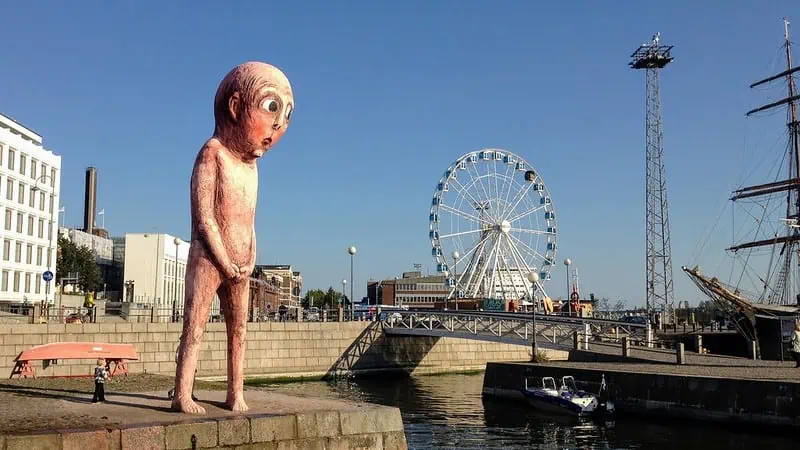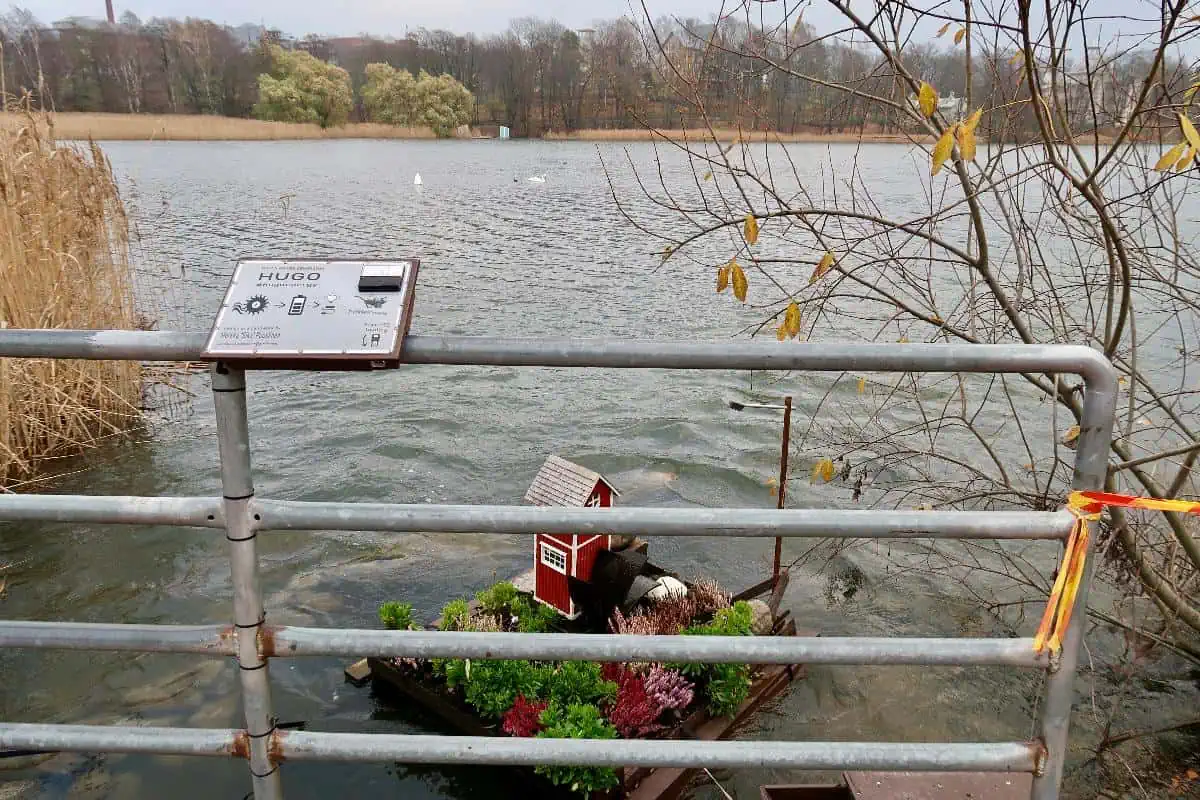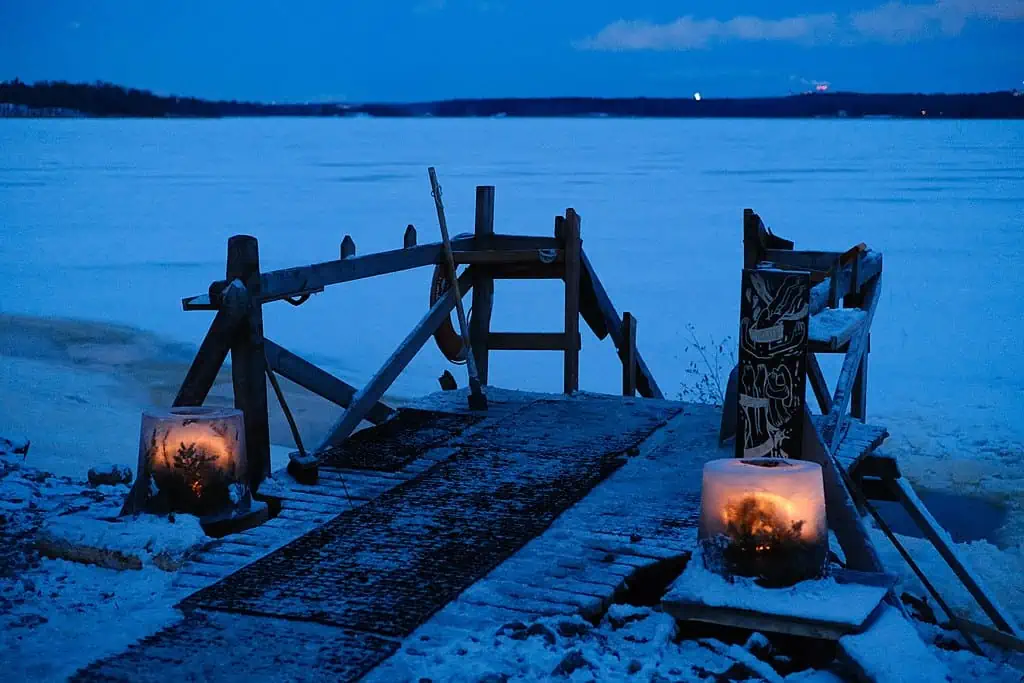
Beneath the frosty surface of Finland’s capital city lies a sizzling hub of art, culture and architecture. Despite enduring dark winters and icy temperatures, the Finns rank as some of the happiest people in the world, with Helsinki leading the way for high standards of living. Visitors who wish to explore this Nordic city, will in turn discover a plethora of verdant parks, world-class restaurants, beautifully-designed monuments and apparently, also dozens of hidden gems that tell the story of a multi-faceted place.
Appearing taken aback at being discovered, this towering statue is difficult to miss, standing 8.5 metres tall in the middle of Helsinki’s West Harbour district of Jätkäsaari. The blushing pink man first made its debut by seemingly urinating into the waters of the East Harbour, in full view of tourist rides and ferry terminals. It has since moved away from the waterfront to stand outside the Helsinki Computer and Game Console Museum, where it sheepishly pees on the sidewalk.
The charming figure was built by local sculptor Tommi Toija, who claims the piece explores human vulnerability. Aiming for the “little dude” to be neither young nor old, the artist hopes the piece might appeal to the inner hearts of humans worldwide. He wants his art to reach past the formal personas and social norms people often hide behind in everyday life.

The whimsical sculpture of Bad Bad Boy
photography by: Felipe Tofani/ Flickr
Between the cities of Helsinki and Espoo sits an island named Lehtisaari, which means “leafy.” Living up to its name, the dense trees on this island hide the remains of several Bronze Age burial tombs. Although this historic site is easily accessed, many people do not realise the significance of these mounds of stones, often walking past them blissfully unaware.
One of the tomb locations is clear, however, since it’s found in a park named Hiidenkiukaanpuisto – translating to “park of the heap tomb”. At the top of the hill is a small sign to indicate the mound is protected by law. The ten-metre-wide, circular tomb of stones encases a large rock-slab casket. While the identities of those inhumed have been lost to history, their final resting places continue to be respectfully preserved.
In addition to the ancient wonder of the mounds, their hilltop locations serve as a lovely vantage point of the nearby bay area.

The pile of stones marking the burial site in Lehtisaari
photography by: Wapakk/ Wikimedia Commons
Popular for lakeside strolls amongst its parklands, Töölö Bay, near the centre of Helsinki, has a number of unique attractions. Its highlight is a functional artwork of a mini red powerhouse built amongst the shallows. Complete with a spinning waterwheel powered by a drain pipe, the hydroelectric plant provides enough energy to light the adjacent street lamps, as well as power for an attached mobile phone charger.
The artist, Markku “Sika” Puustinen, named the piece Hugo after his granddaughter. He says all of the parts of the power plant are recycled, using motors that were taken from an old printer and converted into generators. Shortly after the piece was first unveiled, Puustinen spent an hour watching and documenting how passers-by reacted to his work. He reported that 714 people stopped to look at the power plant, while 115 were distracted by their mobile phones.
Located near the northern end of the bay, the artwork is fringed by the Helsinki Winter Garden, featuring hundreds of species of plants. Additionally, the area is considered a top spot for bird watching.

The micro hydroelectric power plant in Töölö Bay
photography by: Helsinki City Museum
Popular for sledding in the winter, Taivaskallio is a park in the northern area of Käpylä featuring a 60-metre-high hill. Once an important site for the Helsinki air defence regiment called Taivas, meaning “Heaven”, the mound is still home to some anti-aircraft batteries and a sealed anti-aircraft gun that were used during World War II. While it was the tallest hill in Helsinki at the time, it has since been overtaken by the creation of the artificial hill Malminkartanonmäki, which stands 90 metres above sea level.
Alongside its historical significance, the park also caters for a host of outdoor activities during the summer, including rock climbing and bouldering as well as the harvesting of wild berries across the verdant slopes. In contrast, at the height of the winter, locals gather on the hill on New Year’s Eve to watch the city’s spectacular fireworks.

The remnants of an anti-aircraft battery in Taivaskallio
photography by: Heikki Kastemaa/ Wikimedia Commons
The industrial port area of southern Munkkisaari and Hernesaari has been beautified by a mobile, kilometre-long wall of art. Built with the intention of hiding unsightly construction works in the area for ten years, local graphic design students entered a competition for the honour of decorating the waterfront precinct. The winning entry was titled Helsinki 24h, and combines 24 depictions of Helsinki, each representing an hour of the day.
Many of the images portray intriguing angles of Helsinki outside the usual tourist attractions. The artists from Aalton University, Armi Teva and Miia Puustinen, wanted to take viewers for a visual tour of a potential day in the life of a Helsinkian. The work was unveiled with an opening ceremony on June 12th, 2018, marking the beginning of the ten-year exhibition. Current construction works aim to shift the industrial area into an active residential and leisure area, with homes for 7,500 residents under development.

The extra-long graffitied wall in Hernesaari (on the left)
photography by: Tuula Sipil/ Wikimedia Commons
Known as Helsinki’s most public sauna, Sompasauna is open 24 hours per day, every day of the year. Since it’s free and open to everyone, visitors are expected to pitch in with its maintenance. This means if you use one of the three saunas, you should also contribute by cleaning up, fetching water or sawing wood.
Genders are mixed and clothing is optional here; there are toilets, but no showers or changing rooms. Located on the western bank of Vanhankaupunginselkä Bay, fresh Baltic waters are right outside for those who want to (rapidly) cool down post-sauna. Lockers are available to store belongings for those who bring their own padlock.
The wooden saunas are colourfully painted and a relaxed, respectful environment is encouraged by the Sompasauna Association, which rents the land from the City of Helsinki.

The staircase leading to the frigid waters of the Baltic Sea, where the sauna bathers cool themselves
photography by: Safa Hovinen/ Wikimedia Commons
Just off the eastern coast of Helsinki’s central business district is the small island of Korkeasaari. One of the oldest zoos in the world, Korkeasaari Zoo, makes up most of the island. Near the western bank of the 22-hectare zoo island sits Korkeasaaren Näköalatorni, an observation tower that looks out over the nation’s capital.
From its clifftop perch, the ten-metre lookout tower provides a 360-degree view of Helsinki and its surroundings. The woven timber tower, named Kupla, was the winning entry of a student architecture competition held in the year 2000. The winning student, Ville Hara, is now a co-owner of the local architecture firm Avanto Architects. They claim the bubble shape was chosen to give an organic and sustainable look, opposing the rigid straight lines favoured by Western culture at the time.

The bottom part of Korkeasaari Observation Tower
photography by: Mace Ojala/ Flickr
A 30-minute drive along the highway north of Helsinki is the Lemminkäisen Kallio, or Plane Spotters’ Lookout. As the name suggests, this is a popular spot for aeroplane enthusiasts to watch the take-offs and landings that pass overhead to and from Helsinki Airport. Featuring a large rocky area to perch upon, the lookout has recently become a pilgrimage site for enthusiastic spotters who opt to spend an afternoon, gawking at these flying beasts.
Locals suggest rolling out a blanket on the sun-warmed rock and laying on your back to keep your eyes on the sky. As the sound can be extremely loud, earplugs are suggested for anyone sensitive to noise.